Alan Paul's Blog, page 26
August 18, 2015
Review of Live at the Fillmore East and West â by Bob Lefsetz
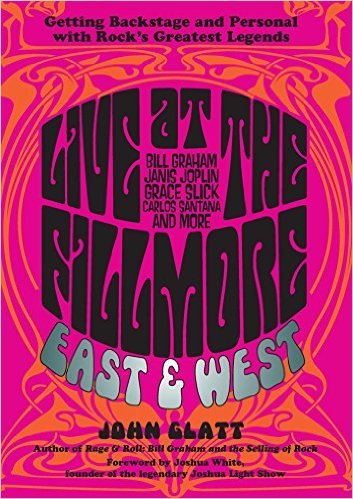 Bob Lefsetz writes a music industry newsletter I find consistently interesting and enlightening. I recommend subscribing and checking out his archives here.
Bob Lefsetz writes a music industry newsletter I find consistently interesting and enlightening. I recommend subscribing and checking out his archives here.
He reviewed a new book about the Fillmores. I have not read it yet, but am going to buy based on his review, which I present to you here.
*
“Live at the Fillmore East and West: Getting Backstage and Personal with Rock’s Greatest Legends”: http://amzn.to/1IXOc7q
Review Written By Bob Lefsetz:
What people don’t understand is classic rock was a revolution, populated by the disenfranchised, hungry to have fun and make a difference. To think that these degenerates could conquer the world and lead a nation was anathema to the powers-that-be, the same way they were confounded by the nerds who took over the world with tech in the twenty first century.
Janis Joplin was an outcast looking for acceptance who never got it until she demonstrated her greatness and made it. Then it killed her.
Carlos Santana was a street urchin from Tijuana who would still be an unknown if it weren’t for Bill Graham.
Grace Wing was a rich girl’s daughter, who thrived on the privilege and then deemed it necessary to test limits, whiplashing her band and the entire nation in the process.
And we ate it all up. We went to the Fillmore and then Woodstock. Money started to rain. And then cocaine flew up everybody’s noses and the entire scene matured and has never been the same.
I don’t expect anyone under thirty to read this book. Because they believe that they’re in charge and the world is their oyster. But in the fifties and early sixties this was not the case. Kids were subservient. The old white men ruled. You were afraid of your mom and dad, they weren’t your best friends. And then we heard the music.
It didn’t start in the suburbs. There was no internet, never mind cable TV. If you didn’t live in the metropolis, if you weren’t within earshot of the city airwaves, you were out of the loop, a year or two behind. By time the band was on Ed Sullivan there was a whole new crop of acts the cognoscenti were into. But you didn’t know them. There was no social media, the newspaper was everything, and even if the newspaper reported, young people did not read it, it was for the oldsters.
And then came the radio.
This book barely focuses on the recording side of the equation, which has been lauded ad infinitum. This is all about the gig, the live performance, where most of these acts made their bones. The Beatles started live, as did Joplin, Santana, the Jefferson Airplane and the Dead, all of whose careers are profiled herein. They were outsider musicians, back when you could survive on a few dollars a week, when life was about opportunities instead of closed doors.
There are so many inaccuracies and misspellings in this book you’ll be horrified.
But you’ll also learn inside details you never knew.
Bill Graham was making the lion’s share of the dough, but he built the scene, there were no concomitant promoters to compete with him until the acts could sell themselves. Which is how they ended up with ninety percent of the gross. You can count the number of people in attendance, you cannot count how many records have been shipped, stolen or bought. The record company kept that info private, and still does. But the rubber meets the road at the gig. And that’s where the fire is lit. All these acts made it based on their performances, most significantly at Woodstock.
You’ve got no idea how big the movie and attendant triple album were. Sure, the Beatles may have conquered America, but they were safe, Brian Epstein cleaned them up. No one cleaned up Janis Joplin or Grace Slick or Carlos Santana. And when you saw them perform you wanted so much more.
And they didn’t give a fuck. Sure, they liked the money. But they could offend the audience, they were on their own trip. And it was so different from today.
I wasn’t planning on reading this book. But going through a pile of what was sent to me I uncovered it and got hooked. Every night I couldn’t put it down. I went down the rabbit hole to what once was and will never be again.
You see the scene was nascent, no one knew what was happening, and then the worm turned and it hasn’t been the same since. Kinda like the web was for exploration, before pop-up ads and all kinds of shenanigans made it lucrative for the usual suspects. If you were surfing in 1995 you remember the naked women tracking their every move, the people detailing their lives, it wasn’t about money so much as self-fulfillment and exhibitionism.
And there’s a healthy dose of exhibitionism in rock and roll.
You can make music. You can make money.
But you cannot become one of the richest people in the world. To do that, you had to play music in the sixties and seventies. When fans gave the acts all their dough. Because without music life was empty. Hit singles counted, but where you were going was more important than staying still.
Albert Grossman tried to get Janis Joplin clean. Bill Graham did a great job of managing the Airplane. But the musicians didn’t want to listen. They wanted to be free, to their detriment, Paul Kantner admits this.
But it was this specific middle finger to the powers-that-be, to the establishment, that made them so attractive.
Don Henley was right, we haven’t had that spirit here since 1969.
But if you want to know what it was like, read this book.
—
Visit the archive: http://lefsetz.com/wordpress/
Review of Live at the Fillmore East and West – by Bob Lefsetz
 Bob Lefsetz writes a music industry newsletter I find consistently interesting and enlightening. I recommend subscribing and checking out his archives here.
Bob Lefsetz writes a music industry newsletter I find consistently interesting and enlightening. I recommend subscribing and checking out his archives here.
He reviewed a new book about the Fillmores. I have not read it yet, but am going to buy based on his review, which I present to you here.
*
“Live at the Fillmore East and West: Getting Backstage and Personal with Rock’s Greatest Legends”: http://amzn.to/1IXOc7q
Review Written By Bob Lefsetz:
What people don’t understand is classic rock was a revolution, populated by the disenfranchised, hungry to have fun and make a difference. To think that these degenerates could conquer the world and lead a nation was anathema to the powers-that-be, the same way they were confounded by the nerds who took over the world with tech in the twenty first century.
Janis Joplin was an outcast looking for acceptance who never got it until she demonstrated her greatness and made it. Then it killed her.
Carlos Santana was a street urchin from Tijuana who would still be an unknown if it weren’t for Bill Graham.
Grace Wing was a rich girl’s daughter, who thrived on the privilege and then deemed it necessary to test limits, whiplashing her band and the entire nation in the process.
And we ate it all up. We went to the Fillmore and then Woodstock. Money started to rain. And then cocaine flew up everybody’s noses and the entire scene matured and has never been the same.
I don’t expect anyone under thirty to read this book. Because they believe that they’re in charge and the world is their oyster. But in the fifties and early sixties this was not the case. Kids were subservient. The old white men ruled. You were afraid of your mom and dad, they weren’t your best friends. And then we heard the music.
It didn’t start in the suburbs. There was no internet, never mind cable TV. If you didn’t live in the metropolis, if you weren’t within earshot of the city airwaves, you were out of the loop, a year or two behind. By time the band was on Ed Sullivan there was a whole new crop of acts the cognoscenti were into. But you didn’t know them. There was no social media, the newspaper was everything, and even if the newspaper reported, young people did not read it, it was for the oldsters.
And then came the radio.
This book barely focuses on the recording side of the equation, which has been lauded ad infinitum. This is all about the gig, the live performance, where most of these acts made their bones. The Beatles started live, as did Joplin, Santana, the Jefferson Airplane and the Dead, all of whose careers are profiled herein. They were outsider musicians, back when you could survive on a few dollars a week, when life was about opportunities instead of closed doors.
There are so many inaccuracies and misspellings in this book you’ll be horrified.
But you’ll also learn inside details you never knew.
Bill Graham was making the lion’s share of the dough, but he built the scene, there were no concomitant promoters to compete with him until the acts could sell themselves. Which is how they ended up with ninety percent of the gross. You can count the number of people in attendance, you cannot count how many records have been shipped, stolen or bought. The record company kept that info private, and still does. But the rubber meets the road at the gig. And that’s where the fire is lit. All these acts made it based on their performances, most significantly at Woodstock.
You’ve got no idea how big the movie and attendant triple album were. Sure, the Beatles may have conquered America, but they were safe, Brian Epstein cleaned them up. No one cleaned up Janis Joplin or Grace Slick or Carlos Santana. And when you saw them perform you wanted so much more.
And they didn’t give a fuck. Sure, they liked the money. But they could offend the audience, they were on their own trip. And it was so different from today.
I wasn’t planning on reading this book. But going through a pile of what was sent to me I uncovered it and got hooked. Every night I couldn’t put it down. I went down the rabbit hole to what once was and will never be again.
You see the scene was nascent, no one knew what was happening, and then the worm turned and it hasn’t been the same since. Kinda like the web was for exploration, before pop-up ads and all kinds of shenanigans made it lucrative for the usual suspects. If you were surfing in 1995 you remember the naked women tracking their every move, the people detailing their lives, it wasn’t about money so much as self-fulfillment and exhibitionism.
And there’s a healthy dose of exhibitionism in rock and roll.
You can make music. You can make money.
But you cannot become one of the richest people in the world. To do that, you had to play music in the sixties and seventies. When fans gave the acts all their dough. Because without music life was empty. Hit singles counted, but where you were going was more important than staying still.
Albert Grossman tried to get Janis Joplin clean. Bill Graham did a great job of managing the Airplane. But the musicians didn’t want to listen. They wanted to be free, to their detriment, Paul Kantner admits this.
But it was this specific middle finger to the powers-that-be, to the establishment, that made them so attractive.
Don Henley was right, we haven’t had that spirit here since 1969.
But if you want to know what it was like, read this book.
—
Visit the archive: http://lefsetz.com/wordpress/
August 11, 2015
Interview with Gregg Allman Band guitarist Scott Sharrard
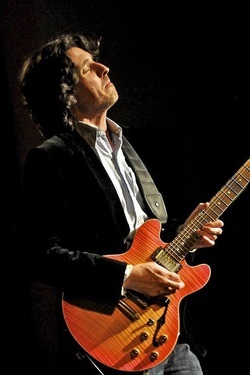
My Gregg Allman Wall Street Journal interview kicked up a lot of dust because of what he said about Dickey Betts: “I would love to play with him again.” You probably already saw all that.
The reason for the interview was Gregg’s excellent new live CD and DVD Gregg Allman Live: Back To Macon, GA CD and Blu-Ray and in talking to Gregg one thing that was clear is how much he loves his current band. He singled out every single member for praise and told me several times how dissapointed he was that current keyboardist Pete Levin was not yet int he band when they recorded the live album.
To get a little deeper into all this, I got in touch with GA Band guitarist and Musical Director Scott Sharrard.
I am looking forward to seeing the Gregg Allman Band at the Peach Music Festival Friday night – and also to the inaugural Laid Back Festival, which will be August 29 at Jones Beach. That one also features the Doobie Brothers, Bruce Horsby and the Noisemakers, Bernie Williams, Jaimoe’s Jassz Band and others as well as great local food and craft beer. See local friends out there.
How long have you played with Gregg?
I joined the band in the Fall of 2008, so about 7 years.
How have you seen him change in his approach?
Gregg’s health was in jeopardy for the first few years I was in the band. Even once he got his liver transplant there were unforeseen complications afterwards. Through all of it Gregg gave some incredible performances and we had some amazing tours.
As far as changing his approach to music I think Gregg has had a process that works for a long time. Like all the great band leaders he knows how to surround himself with talented people who help him to sound his best and push him at the same time. His health now is really good and his energy is very positive so the sky’s the limit once that happens…
Does he seem more confident?
Definitely
Have you noticed any changes in his approach since the ABB are gone and GAB is his full-time gig?
Gregg loves the Brothers and his band. As far as why those guys retired now, you’d have to ask them…but it would seem self evident that now would be the time to focus their creative energies on solo pursuits.
Gregg has gone headlong into his band. He’s writing and we are adding songs to our repertoire all the time, especially some gems from his back catalog for our live show.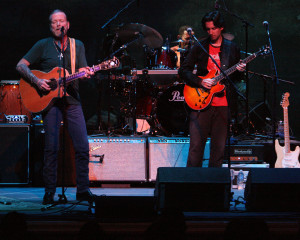
As MD, you hire the band. How involved is he in the decision making?
I make suggestions and so do guys from within the band. Gregg then checks out the player and gives his blessing or asks me to keep looking for another guy. The band we have right now seems to be the perfect fit.
What is something musical about Gregg that people would be surprised to learn?
I don’t know if people would be surprised but Gregg is always checking out the masters and listening constantly. The other day I went to his room and he was blasting Pharaoh Sanders! He also always goes to the deep blues well and finds constant inspiration. Muddy, Howlin Wolf, Bobby Bland those guys are constant. Gregg is part of that generation of Rock and Roll innovators that always build off the blues. That’s why we love them!
How are you feeling about the chances of recording with this band in Muscle Shoals?
Well there are a lot of variables; we are talking about the music business here! But Gregg and I have written a couple of tunes and he has a couple in the chamber as well as some great cover ideas. I’ve heard that Don Was might be involved which would be fantastic. Whatever happens I sure hope someone records this band because it is very special and, given the chance, I think we could help Gregg make a great record – maybe the best of this period if we are lucky!
Anyway, for now we are just happy to play and grow as a band under Gregg’s direction. Its always a ball traveling and playing with these guys, its become like a family out here…
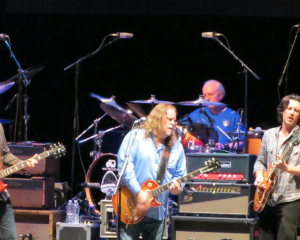 How did you first hook up with Gregg?
How did you first hook up with Gregg?
I was playing guitar in Jay Collins’ band around New York City for a few years and he was trying to convince Gregg to hire me for a while. At the time Gregg had no idea who I was but eventually I got my shot to play with him when I sat in with the Allman Brothers at a shed in Camden, NJ. It was very last minute. Jay called me up the day before and told me to meet him and we would head out.
I met Gregg before we jammed of course and we really hit it off from jump street. I think he really liked the fact that I knew who Wayne Bennett, was to be honest! Wayne was the guitarist for Bobby Blue Bland for many years. The interplay between Bobby’s voice and Wayne’s guitar on some of those early recordings was a big inspiration for that call and response style of guitar and voice you can hear Duane and Gregg doing on the early Allmans records. I was very familiar with Wayne’s licks and that was a bonus. Then I sat in and we just took it from there. That was in the Fall of 2008 and its been full steam ahead ever since…
What is the latest with your own band?
We are based in New York City, and we have residency at a great little spot in Brooklyn called Bar Chord where we play every Thursday night when I’m not on the road. Man, we have had some great cats come play with us as guests, Ian Hendrickson Smith [Sharon Jones, The Roots, Amy Winehouse, Jimmy Fallon Band Saxophonist and Horn Arranger] comes down and plays with our buddy Marcus Parsley (Trumpet for JJ Grey, Sharon Jones) and they are a killer section. We also have Scott Metzger (Phil Lesh, Joe Russo’s Almost Dead) join us on guitar sometimes, Teddy Kumpel and Clark Gayton have come down. It’s a great place to hang and play.
I also have plans to bring my band to Memphis to make a new album of original material and my buddies from The Bo Keys will be involved with that alongside some of the original Hi Records rhythm section. We hope to record that this winter. I also have a great new management team with a new company called Busters Main Stem and those guys are kicking ass getting us set up for some more touring in between Gregg Allman runs. Its gonna be a busy year for sure!
July 22, 2015
Warren Haynes and Railroad Earth plus other friends â DelFest 2011
In honor of the release of Ashes & Dust and the fact that I’ll be seeing Warren Haynes and Railroad Earth at New York’s Town Hall, I present to you the 2011 DelFest jam that unofficially launched his Americana kick. This is Warren’s entire 90-minute performance and also features bassist Ron Johnson, my man Ron Holloway and more…
Warren Haynes and Railroad Earth plus other friends – DelFest 2011
In honor of the release of Ashes & Dust and the fact that I’ll be seeing Warren Haynes and Railroad Earth at New York’s Town Hall, I present to you the 2011 DelFest jam that unofficially launched his Americana kick. This is Warren’s entire 90-minute performance and also features bassist Ron Johnson, my man Ron Holloway and more…
July 14, 2015
Warren Haynes announces tour dates with Ashes and Dust Band
 Warren Haynes has announced a fall tour with his new project, the Ashes & Dust Band. The group, which features drummer Jeff Sipe and string trio ChessBoxer, will kick off its tour in Kansas City on September 22 in support of Haynes’ forthcoming albumAshes & Dust (Feat. Railroad Earth). A couple of those dates will also include appearances by special guest Chris Stapleton.
Warren Haynes has announced a fall tour with his new project, the Ashes & Dust Band. The group, which features drummer Jeff Sipe and string trio ChessBoxer, will kick off its tour in Kansas City on September 22 in support of Haynes’ forthcoming albumAshes & Dust (Feat. Railroad Earth). A couple of those dates will also include appearances by special guest Chris Stapleton.
Warren will also play a number of shows in support of the Ashes and Dust with Railroad Earth, who backed him on the record. Those shows will take place in August, and will be followed by Haynes outing with the Ashes & Dust Band.
Tickets for the Ashes & Dust Fall Tour will go on sale this Friday, July 17.
Warren Haynes Tour Dates
July 17 Alta, WY—Targee Fest
July 23 New York, NY—Town Hall
August 1 Bridgeport, CT—Gathering of the Vibes**
August 3 Wilmington, NC—Greenfield Lake Amphitheater*
August 4 Charlotte, NC—The Fillmore*
August 6 Cincinnati, OH—Riverbend Music Center*
August 7 North Tonawanda, NY—Rockin’ on the River*
August 8 Baldwinsville, NY—Paper Mill Island Amphitheater*
August 9 Burlington, VT—Waterfront Park*
August 14 Scranton, PA—Peach Music Festival
August 15 Lowell, MA—Lowell Summer Music Series
September 10-13 Arrington, VA—Lockn’ Festival^
September 22 Kansas City, MO—Uptown Theatre
September 23 Indianapolis, IN—Murat Theatre
September 24 Columbus, OH—LC Pavilion
September 25 St. Louis, MO—The Pageant
September 26 Chicago, IL—The Riviera Theatre
September 29 Detroit, MI—The Fillmore
September 30 Pittsburg, PA—Stage AE%
October 1 Port Chester, NY—The Capitol Theatre%
October 2 Upper Darby, PA—Tower Theater
October 3 Portland, ME—State Theatre
October 6 Boston, MA—Orpheum Theatre
October 7 Westbury, NY—The Space at Westbury
October 8 Washington, DC—Warner Theatre
October 10 Atlanta, GA—Tabernacle
October 13 Nashville, TN—Ryman Auditorium
October 20 Charleston, SC—Charleston Music Hall
October 22 Miami Beach, FL—The Fillmore Miami Beach
October 23 St. Petersburg, FL—Jannus Live
October 24 Orlando, FL—Plaza Live
November 6 Frederikshavn, Denmark—Blues Festival
November 8 Berlin, Germany—Kesselhous
November 15 Paris, France—Café De La Danse
November 18 Cleon, France—La Traverse
(*) w/ Railroad Earth
(**) sets with both Railroad Earth and The Seaside Allstars
(^) w/ Phil Lesh & Friends with Carlos Santana, Barry Sless, Rob Barraco & John Molo
(%) w/ special guest Chris Stapleton
James Brown teaches you how to Boogaloo.
 In case you were wondering how to do the Boogaloo, Camel Walk, Soul Train or Mashed Potatoes, the Godfather of Soul has you covered:
In case you were wondering how to do the Boogaloo, Camel Walk, Soul Train or Mashed Potatoes, the Godfather of Soul has you covered:
July 9, 2015
Gregg Allman – Tuesday’s Gone
Gregg Allman performing Tuesday’s Gone at Atlanta’s Fox Theatre, as part of the tribute to Lynyrd Skynyrd, One More For The Fans – available JUly 25.
July 6, 2015
Fare Thee Well – Grateful Dead say an emotional good bye
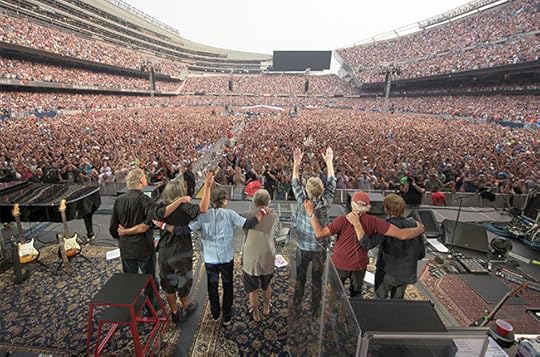
Pre-show Bow and thanks. Photo- Jay Blakesberg
Last night’s final Fare Thee Well show; the final joint appearance ever by the Grateful Dead’s Core Four of Bob Weir, Phil Lesh, Mickey Hart and Bill Kreutzmann if you take them at their word – began and ended the same way: with a group bow and a huge roar from a giant crowd.
It was that kind of night: emotionally heightened, with cheers and tears around every corner for the highly amped fans. The good vibes were palpable throughout Soldier Field and inseparable from the music. I’m reviewing and writing about the experience of being in the stadium. If you wanted to write a removed analysis of the music performed, you’d be better off staying at home and watching a simulcast through a great system by yourself. Walk into the show and you’re impacted by everything around you.
Spending three days in record crowds of up to 71,000 (last night’s released number) was an overwhelming experience. As my friend Jay said, there was as much community feeling as in any crowd ever. No one paid for me to be here. I bought my tickets, paid for my travel and joined the masses entering and exiting like rats in a maze. And like everyone else there, I was invested on many levels. None of us walked out feeling cheated.
After the bow and crowd roar, the first set started out strong with “China Cat Sunflower” > “I Know You Rider,” songs people have been waiting for every day. It all clicked, with Trey Anastasio stepping to the fore and Weir smiling like the Cheshire Cat as he stepped to the mic to sing his part of the “I Know You Rider” chorus harmony. During an excellent “Estimated Prophet” that followed, Weir was jumping around as he engaged Anastasio.

Copyright Jay Blakesberg
The strong, in sync playing continued throughout the first set. Anastasio has established great rapport with keyboardists Bruce Hornsby and Jeff Chimenti, with the three often engaging in call and response, harmony and counterpoint. “Built to Last” was nicely played, but remains a rather slight song in my estimation. “Samson and Delilah” was strong, with Chimenti throwing down a great surging organ solo.
“Mountains of the Moon” was musically excellent, but Lesh’s lead vocal flattened the melody and… well, it was neither the first nor last time a song was musically superb but vocally lacking. It was also, I believe, the first time that song had been played since 1969. I understand that pulling something like that off is part of the Dead ethos, but on the final night, I’d have taken something like Bruce Hornsby singing “Loser” whether or not they played it last week in Santa Clara. Emphasizing not repeating a song in a five-night run makes no sense to me at a time like this.
The set closed strongly with “Throwing Stones,” with the “Ashes, Ashes” chorus a giant sing-along each time through and a very nice jam in the middle, involving everyone, that was one of the musical highlights of the concerts to that point.
Have you checked out my new Ebook, Reckoning: Conversations With the Grateful Dead? Click on through. It’s cheaper than your coffee!
Set 1
China Cat Sunflower > I Know You Rider
Estimated Prophet
Built to Last
Samson and Delilah
Mountains of the Moon > Throwing Stones
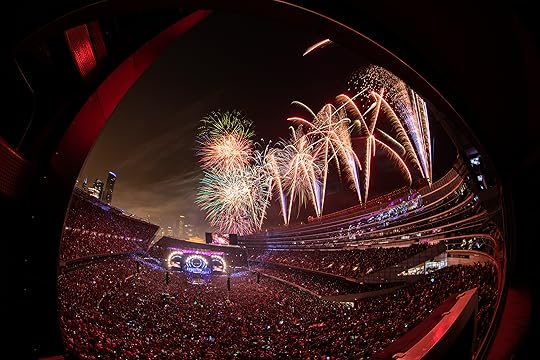
Pre-set fireworks. Photo – Chad Smith
The second set – and perhaps the final in the Dead’s 50-year history – began with fireworks. Literally, a gorgeous, extended display over the stadium that made clear again that this was not a normal night. And after a nice, swirly intro, the band kicked into “Truckin’, ” a song that just HAD to be repeated and it was a great, hard-driving version. “What a long strange trip it’s been” was greeted with roars and mass sing-alongs every time through.
The song wound down into a little jam that segued beautifully into “Cassidy,” which featured another stellar extended jam, highlighted by some nifty harmony playing by Weir and Anastasio and sweet interplay between Trey and Hornsby. The jam went a bit atonal, before Lesh took the lead pumping it back up and leading straight back into another, final verse. The strong start continued right into “Althea.” This aggregation does slinky really well and showed it again here. Trey sang the song beautifully and Hornsby helped it swing.
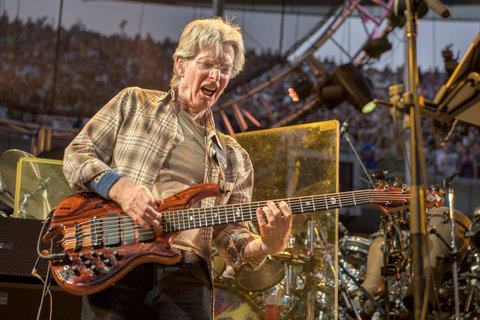
Photo – Jay Blakesberg
As the band came down, some familiar piano notes tinkled and the crowd roared: “Terrapin Station” was under way. Lesh took the first verses, Weir the latter. And while neither made anyone forget about Jerry Garcia, it all worked. The whole suite was beautifully rendered, superbly played and emotionally resonant.
Next up was a Space > Drums segment that was highly entertaining. I gladly squatted on the floor, taking a load off my legs, and looked up away from the stage watching Bill and Mickey do their mad scientist thing on the enormous Jumbotron on the stadium’s far side. That was quite the first half of a set. And then, of course, things got a little weird. Because the Dead need to get weird; they have a perverse sense of equilibrium. It’s just part of their DNA.
They came out of Space and landed on “Unbroken Chain,” another Phil lead vocal. The song was strong but as the tension seemed to build to a resolution that could only be a hard rocker, the group went into the molasses slow “Days Between,” one of Garcia and Robert Hunter’s final compositions. Again, this was not on most people’s list of essential Dead listening, but players gonna play.
We finally got the hard-rocking resolution next with “Not Fade Away,” which had the whole stadium singing along and jumping up and down. I looked up and saw the entire upper concrete structure bouncing, a site I will never forget. As the band walked off stage, the crowd continued the rhythmic five-beat clapping rhythm and kept singing the “Not Fade Away” chorus.
Finally, Lesh returned for his donor rap and everyone returned for “Touch of Grey” that felt inevitable, as retrospective photos flashed on the screen and the audience cheered every shot of Jerry. Trey took the first vocals, then Weir took over.
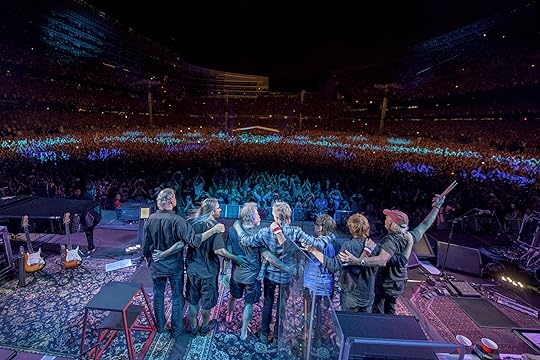
Copyright Jay Blakesberg
The band returned with Weir on acoustic and the rest of the frontline sans instrument for a quiet, guitar and piano “Attics of My Life” as the retrospective photos rolled through. Photos of deceased members and associates flashed by: Ken Kesey, Keith Godchaux (and the very much alive but absent donna), Brent Mydland (to great cheers), Vince Welnick… and then onto new Jay Blakesberg portraits of the current members, in this order: Phil, Bill, Chimenti, Hornsby, Mickey, Trey and Bob. God knows what went into choosing the order; I’ll let someone else sort that out.
And then, finally, it was over and we were back where we started: a full stadium stomping, hooting and hollering as the band stood in the middle of the stage alternating hugs and bows.
The masses filed out, shoulder to shoulder, a giant crowd moving with purpose and total peace through a maze. In a tunnel near the final exit, someone started a rhythmic five-note clap and everyone picked up and we all sang together: “Not, not, not fade away.”
Set 2
Truckin’
Cassidy
Althea
Terrapin Station
Space > Drums
Unbroken Chain
Days Between
Not Fade Away
Encore:
Touch of Grey
Attics of My Life
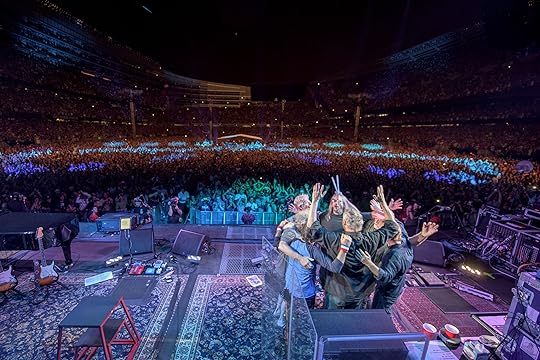
Copyright Jay Blakesberg
July 5, 2015
“Standing On The Moon” – Fare The Well 4th of July (Night 2 Chicago)
A little taste of last night’s show, via the official video: Trey singing “Standing on the Moon”. Soldier Field, Chicago, 7-4-15, Second Show.



